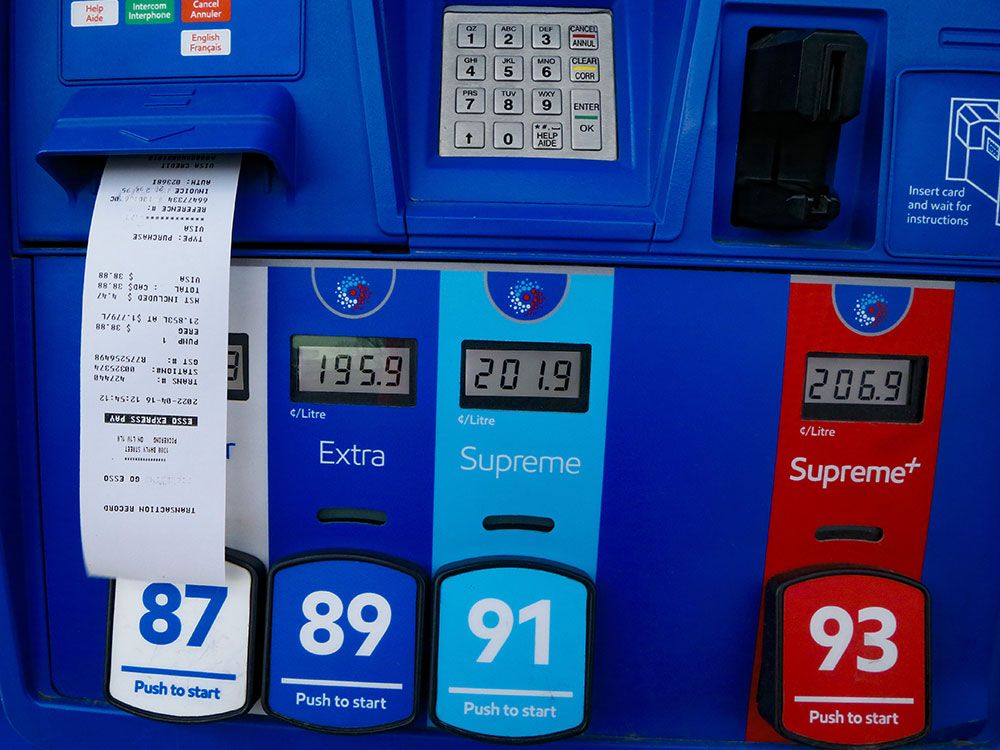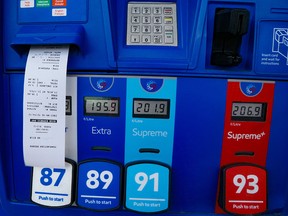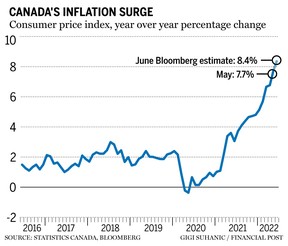Peak prices? ‘Not just yet’ — What experts say about our hot inflation

The only question now is whether Bank of Canada hikes 50 or 75 bps in September, says economist

Article content
The Canadian economy saw the pace of inflation hit 8.1 per cent year over year in June, the fastest since January 1983. Despite the latest reading coming up short of economists’ expectations of 8.4 per cent, the consumer price index breaching eight per cent will add more pressure on the Bank of Canada to deliver another supersized rate hike in September.
Advertisement 2
Story continues below
Article content
Gasoline prices, up 54.6 per cent since June 2021, largely added fuel to the inflation fire, according to Statistics Canada. Oil prices peaked in the first week of June, though Canadians still saw a 6.2 per cent month-over-month increase in prices at the pump. Car costs also rose 8.2 per cent as demand outpaced supply, particularly with a global semiconductor shortage.
Canadian economists weighed in to make sense of the numbers and lend their insight on what this means for the Bank of Canada’s next move. Here’s what they had to say:
Royce Mendes, managing director and head of macro strategy at Desjardins:
“The slightly weaker than anticipated inflation readings will come as good news for central bankers trying to control price pressures. Moreover, the more recent fall in global commodity prices is seeing Canadian energy prices declining in July. But the economy is still too hot, and 45 per cent of the CPI basket is now rising faster than seven per cent per year. So the only question left to answer is whether the Bank of Canada hikes rates 50bps or 75bps in September. It looks like the odds are roughly even between the two. With limited data releases between now and the next interest rate decision, a lot will hinge on the July employment reading.”
Advertisement 3
Story continues below
Article content

Karl Schamotta, chief market strategist at Cambridge Mercantile Corp
“The loonie is trading sharply lower as two- and ten-year yield spreads between Canadian and U.S. bonds narrow. Investors still expect the Bank of Canada to hike benchmark interest rates by another three-quarters of a percentage point in early September, but a further easing of inflation pressures is possible before then. Shipping rates, food costs, oil benchmarks, and gasoline prices have all fallen since early June, and the shelter index could drop further as tighter financial conditions remove air from the housing markets.”
It’s really saying something when an 8.1% inflation rate is greeted with a modicum of relief
Douglas Porter, chief economist at Bank of Montreal
Douglas Porter, chief economist at Bank of Montreal:
“Canadian consumer prices came in a little below expectations in June, for a change, but that’s about where the good news ends… The sizzling read came in 2-3 ticks below consensus expectations, but was still enough to drive the annual rate to yet another new multi-decade high. Note that the monthly rise would have been at the upper end of anything seen in the decade before the pandemic, and still represents an annualized increase of just over 8 per cent—so today’s result is better, but not good.”
Advertisement 4
Story continues below
Article content
“It’s really saying something when an 8.1 per cent inflation rate is greeted with a modicum of relief in financial markets because it wasn’t quite as awful as expected… Headline inflation is likely to retreat next month on the pullback in pump prices, but will probably remain quite lofty through the second half of this year. Beyond that, the Bank will be grappling with underlying inflation which seems to be settling into about a 5 per cent clip, according to the many core metrics. And with that, we expect the Bank to continue hiking in September, albeit with a more moderate 50 bp move at that time.”
-

Canada’s inflation rate surges to 8.1% in biggest jump in almost 40 years: What you need to know
-

Exclusive: Tiff Macklem on the Bank of Canada’s surprise rate hike, wrestling inflation and its forecast miss
Advertisement 5
Story continues below
Article content
Kiefer Van Mulligen, economist at The Conference Board of Canada
“After 15 months beyond the Bank of Canada’s inflation target range, have we reached the peak? Not just yet. Price growth continued to be broad-based in June. Month-over-month, all CPI categories continued to expand (in seasonally adjusted terms)… With price pressures still boiling over, we expect that year-over-year changes to the CPI will not start to fall until later this year.”
“The Bank of Canada’s 100 basis point boost to the overnight rate has sent a message. The announcement hit harder than most expected and not by accident. The Bank is currently in the business of upsetting all manner of expectations. Short-term consumer inflation expectations reached record-high levels in the second quarter and expectations increased at all other time horizons. The steeper path that rates are taking will likely impress upon Canadians that the Bank is committed to bringing inflation down. But rates will also have a swifter impact on the real economy, including a harder push against the housing market. The Bank has implied that front-loading rates can increase the chance of a soft landing. But as the brakes start to screech, Canadians are bracing for impact.”
Advertisement 6
Story continues below
Article content
Matthieu Arseneau and Alexandra Ducharme, deputy chief economist and economist at National Bank of Canada
“For the first time in 8 months, headline inflation surprised consensus expectations to the downside… While gasoline prices were still rising in June, food prices finally calmed down, recording their smallest monthly increase in a year. More important, however, was the moderation in the CPI excluding food and energy (+0.35 per cent, m/m), which recorded its smallest increase since December 2021.”
Advertisement 7
Story continues below
Article content
“Does this mean the BoC regrets being so aggressive last week with a jumbo rate hike? Not so fast. While this moderation is certainly reassuring for the central bank, it is important to remember that one month of data does not make a trend, and more importantly, the pace of core inflation has remained in June at an uncomfortable level for the central bank. Still strong hiring intentions in an extremely tight labor market reflected domestic demand that is still far too strong. The rate hikes that have taken place and the one we expect in September (75 bps) should help calm the boiling Canadian economy in the coming months. We believe that the central bank will be able to take a break afterwards to observe how the economy is coping with a policy rate at a level not seen in 15 years. The moderation in inflation that we anticipate should also contribute to the decision to go into wait-and-see mode.”
Advertisement 8
Story continues below
Article content
Tu Nguyen, economist at RSM Canada
“There are signs that the rate rises by the Bank of Canada are working, notably in the housing market. Shelter prices for both renters and homeowners are also increasing at a slower speed compared to May.”
“Even though the pace of price increases has slowed since May and could further slow next month as oil prices slide, it would be premature to declare peak inflation. There are simply too many uncertainties, most of which occur on the international stage, beyond the Bank of Canada’s control. The volatile geopolitical conditions, particularly the Russia-Ukraine war, global supply chain disruptions, and the pandemic are still here. An event in any of these categories could pose another shock in the system that further send prices upward.”
Advertisement 9
Story continues below
Article content
Charles St-Arnaud, chief economist at Alberta Central
“Inflation continued to accelerate in June to a level not seen since 1983 but increased less than expected thanks to a stabilization in food price inflation… In Alberta, inflation accelerated to 8.4 per cent, higher than the national measure. As is the case nationally, most of the inflation is due to higher energy costs, homeownership costs, motor vehicles and food prices. We note that natural gas and electricity prices have increased by 55 per cent and 36 per cent, respectively, over the past year, much more than in the rest of the country and are responsible for the higher inflation rate in the province compared to the Canadian measure.”
• Email: [email protected] | Twitter: StephHughes95
Advertisement
Story continues below







